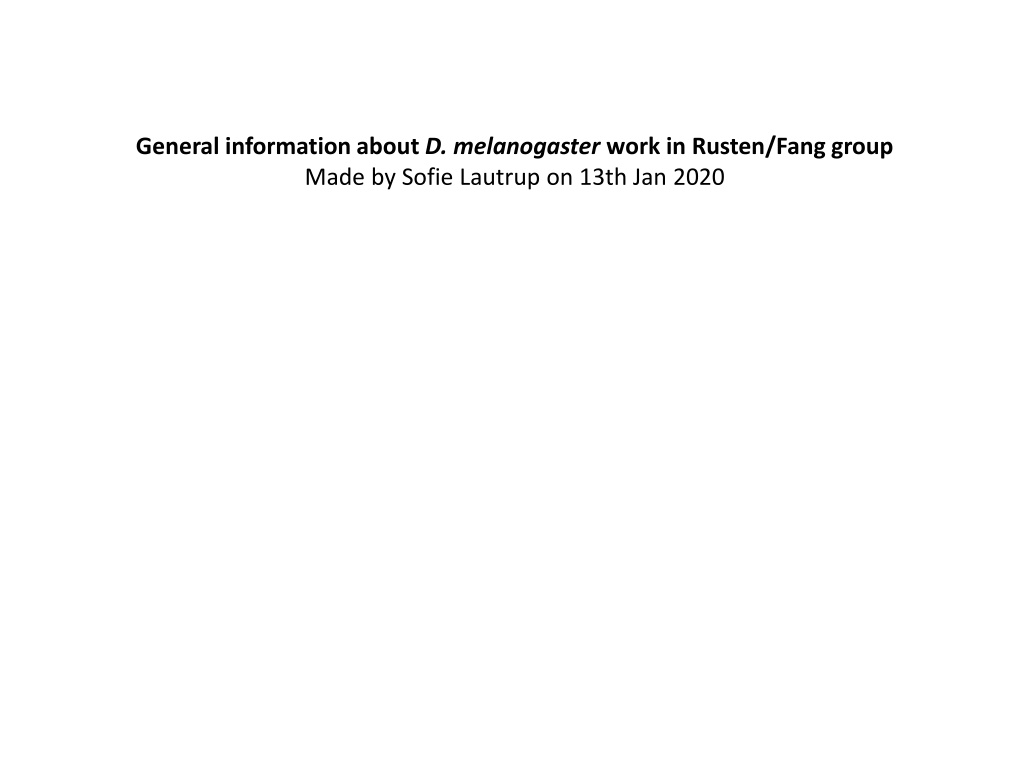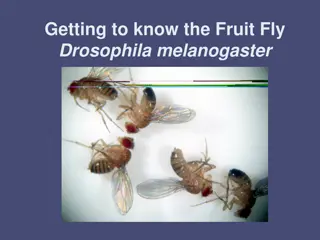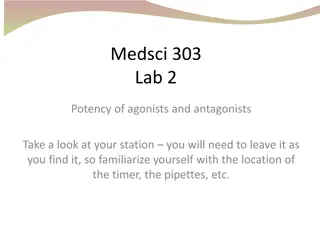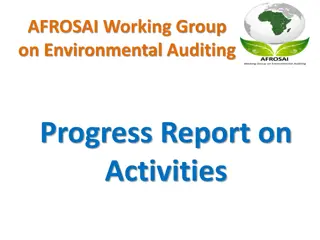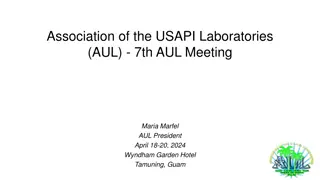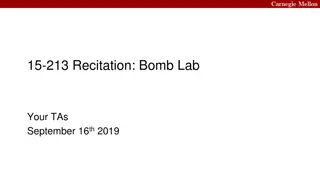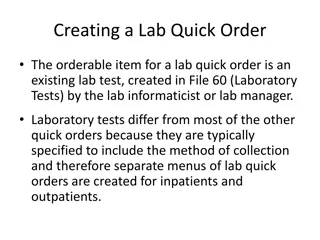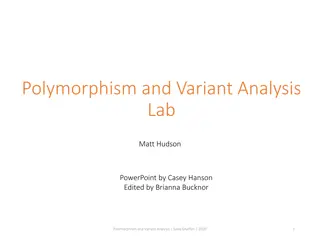Guidelines for Working with D. melanogaster in Rusten/Fang Group Lab
Detailed information about working with D. melanogaster in the Rusten/Fang Group lab located at Radium Hospitalet in Oslo. This includes details on lab location, shared facility, resources, food preparation, recipe, cleaning procedures, and flipping frequency for the flies.
Download Presentation

Please find below an Image/Link to download the presentation.
The content on the website is provided AS IS for your information and personal use only. It may not be sold, licensed, or shared on other websites without obtaining consent from the author. Download presentation by click this link. If you encounter any issues during the download, it is possible that the publisher has removed the file from their server.
E N D
Presentation Transcript
General information about D. melanogaster work in Rusten/Fang group Made by Sofie Lautrup on 13th Jan 2020
Where and who? Located in Forskningsbygget 6th floor at Radium Hospitalet, Oslo We share the fly facility with other labs, mainly Tor Erik Rusten s lab They own all equipment, pay for fly materials etc. so be careful and wise
Useful open resources Flybase.org
Food is prepared by Tor Eriks technician and is placed in the cold room Note on the sheet in the cool room whether you need a lot Note when you will need to flip your stocks and how much food you need Food is prepared in either small vials or larger bottles Lids are found in a cabinet in the small room just before entering the fly lab Dry yeast and plastic ware are in the fly lab. For pensels, tweezer etc, you need to bring your own (Sofie has for her students only) Food you take out of the cold room, but do not use has to be put back as soon as you are done in the fly lab. It cannot stay in the fly lab ON.
Food recipe Prepared by technician in Rusten lab 1 L distilled water 13 g agar 22 g molasses 65 g malt extract 18 g brewer s yeast 80 g corn flour 10 g soy flour 6.2 ml propionic acid 2 g methyl-p-benzoate in 7.3 ml of EtOH For drugs used by Sofie: RU-486 (mifepristone): stock 20 mM in EtOH, final in reaction 200 uM NR, NMN: dissolved in water UA: dissolved in DMSO
When using the fly lab always clean with EtOH after use. This encounters your own equipment (tweezers, pensels etc.) Fly pads, guns, microscope, table etc. In this way, we will avoid contaminations as best as possible.
Flipping and flipping frequency The frequency that you need to flip the flies depends on temperature of storage and what you will use the flies for. Flipping means to transfer the flies from one vial to another. For 18 C stocks: - 2 vials of each strain are kept at 18C. - At 18 C the life cycle of the flies are slower, why we do not have to flip so often. - One of the vials is flipped every 2-weeks, so that each vial is flipped once per 4-5 weeks. - We keep stocks at 18C, since flies can not be recovered from freezing. Flies at 25C: - At 25C the cycle from egg to adult fly is 10 days. - Working stocks: flip 2-3 a week - Stocks wherefrom virgins are needed: flip 3 times a week, add yeast to the bottles. - Crosses: flip 3 times a week, add yeast.
Contaminations Contaminations Strain vs. strain contamination. How to avoid? Fungi and bacteria Mites (Tyrophagus putrescentiae, or Sancassaniamite) Reference: https://www.ncbi.nlm.nih.gov/pubmed/28476862 Video of a mite: https://www.youtube.com/watch?v=l6OMq7vDqdA
The The life life history history of of mite mite (e.g., (e.g., Sancassania Sancassania polyphyllae polyphyllae) ) Reference: Cakmak I. et a., Exp. Appl Acarol, 2011
Cleaning contaminated fly vials The most normal types of contamination: Bacterial contamination: - Can in general be avoided by flipping flies regularly and having enough flies in the vials. - If it happens, best to throw out the vial. - If the vial cannot be thrown out, you can treat with Penicillin/streptomycin, but it has to be for at least 2 full generations. - If the treatment is too short, you risk creating resistant bacteria. - If it is too long, you risk to affect your flies. - Do not do your experiments with P/S treated flies. Mite contamination: - Mite contamination are more common in the fly lab, than in the C. elegans lab. Though, still as serious. - If you see mites in/on your fly vials tell Sofie. - Mites will eat the pupaes and flies and therefore they cannot be used for either stocks, crosses or experiments. - The easiest way to avoid mites are: - To flip regularly - To change the cardboard boxes with the vials regularly (at least once per month) - To check you vials regularly - Not to store old vials in the incubators! - If you get a mite infection best to throw out the infected vials. - There is a drug you can use, but it is also very toxic to the flies. Quarantine incubator - - In an attempt to avoid most contaminations, we have a quarantine incubator. When new vials with flies are received, they should be placed in the quarantine incubator at least 20 days. During this time, you should make sure that there are no contamination in your vials. If there is, better to throw out. -
Genetic Nomenclature https://www.ncbi.nlm.nih.gov/books/NBK20203/ WRN human Wrn-/- mouse wrn-1 (gene) C. elegans (WRN-1 protein) WRNexo (gene) D. melanogaster
Videos for drosophila methods https://www.jove.com/encyclopedia- of- experiments/category/1/drosophila- melanogaster-fruit-fly
Acquiring strains from the Bloomington or VDRC Bloomington https://bdsc.indiana.edu/ VDRC With VDRC you need to pay with your own credit card, then do a reimbursement. https://stockcenter.vdrc.at/control/main Never order without confirming with Evandro first.
